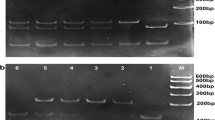Abstract
Noncoding microRNAs regulate the expression of various mRNAs. We attempted to clarify the relationship between miR-27a genome polymorphism and chronic gastritis. The study was performed in 179 patients with no evidence of gastric malignancy. The severity of histologic chronic gastritis was classified according to the updated Sydney system. The frequency of miR-27a G allele was 34.6%. Although the frequencies of miR-27a G allele were increased in subjects with peptic ulcer or severe mucosal atrophy, no significant differences were seen. The miR-27a polymorphism showed an interaction with gender in relation to gastric mucosal atrophy (P=.090). In only male subjects, the miR-27a polymorphism was associated with the gastric mucosal atrophy (P=.039) and both atrophy and metaplasia scores in G/G group were significantly higher than those in the other groups. The miR-27a genome region polymorphism may be an important definitive factor to develop the gastric mucosal atrophy in Japanese male subjects.






Similar content being viewed by others
References
Bartel DP (2004) MicroRNAs: genomics, biogenesis, mechanism, and function. Cell 116:281–297
He L, Hannon GJ (2004) MicroRNAs: small RNAs with a big role in gene regulation. Nat Rev Genet 5:522–531
Miska EA (2005) How microRNAs control cell division, differentiation and death. Curr Opin Genet Dev 15:563–568
O’Donnell KA, Wentzel EA, Zeller KI, Dang CV, Mendell JT (2005) c-Mic-regulated microRNAs modulate E2F1 expression. Nature 435:839–843
Johnson SM, Grosshans H, Shingara J, et al. (2005) RAS is regulated by the let-7 microRNA family. Cell 120:635–647
Ambros V (2004) The functions of animal microRNAs. Nature 431:350–355
Hayashita Y, Osada H, Tatematsu Y, et al. (2005) A polycistronic microRNA cluster, miR-17-192, is overexpressioned in human lung cancers and enhances cell proliferation. Cancer Res 65:9628–9632
Murakami Y, Yasuda T, Saigo K, et al. (2006) Comprehensive analysis of microRNA expression patterns in hepatocellular carcinoma and non-tumorous tissues. Oncogene 25:2537–2545
Cummins JM, He Y, Leary RJ, et al. (2006) The colorectal microRNAome. Proc Natl Acad Sci USA 103:3687–3692
Jemal A, Tiwari RC, Murray T, et al. (2004) American Cancer Society: Cancer statistics, 2004. CA Cancer J Clin 54:8–29
Correa P (1992) Human gastric carcinogenesis: a multistep and multifactorial process. First American Cancer Society Award Lecture on Cancer Epidemiology and Prevention. Cancer Res 52:6735–6740
Suerbaum S, Michetti P (2002) Helicobacter pylori infection. N Engl J Med 347:1175–1186
Covacci A, Telford JL, Del GG, Parsonnet J, Rappuoli R (1999) Helicobacter pylori virulence and genetic geography. Science 284:1328–1333
Uemura N, Okamoto S, Yamamoto S, et al. (2001) Helicobacter pylori infection and development of gastric cancer. N Engl J Med 345:784–789
Rad R, Prinz C, Neu B, et al. (2003) Synergistic effect of Helicobacter pylori virulence factors and interleukin-1 polymorphisms for the development of severe histological changes in the gastric mucosa. J Infect Dis 188:272–281
Rad R, Dossumbekova A, Neu B, et al. (2004) Cytokine gene polymorphisms influence mucosal cytokine expression, gastric inflammation, and host specific colonization during Helicobacter pylori infection. Gut 53:1082–1089
Fei BY, Xia B, Deng CS, et al. (2004) Association of tumor necrosis factor genetic polymorphism with chronic atrophic gastritis and gastric adenocarcinoma in Chinese Han population. World J Gastroenterol 10:1256–1261
Arisawa T, Tahara T, Shibata T, et al. (2006) A F240S polymorphism of protease-activated receptor 2 (PAR2) is not detected in Japanese population with gastro-esophageal symptoms. J Clin Biochem Nutr 39:98–101
Tahara T, Arisawa T, Shibata T, Hirata I, Nakano H (in press) Absence of common polymorphisms of Toll like receptor 4 (TLR4): Asp299Gly, Thr399Ile in patients with gastroduodenal diseases in Japan. J Clin Biochem Nutr
Iwai N, Naraba H (2005) Polymorphisms in human pre-miRNAs. Biochem Biophys Res Commun 331:1439–1444
Zeng Y, Cullen B (2003) Sequence requirements for micro RNA processing and function in human cells. RNA 9:112–123
Dixon MF, Genta RM, Yardley JH, Correa P (1996) Classification and grading of gastritis: the updated Sydney system. Am J Surg Pathol 20:1161–1181
Scott GK, Mattie MD, Berger CE, Benz SC, Benz CC (2006) Rapid alteration of microRNA levels by histone deacethylase inhibition. Cancer Res 66:1277–1281
Meng F, Henson R, Lang M, et al. (2006) Involvement of human micro-RNA in growth and response to chemotherapy in human cholangiocarcinoma cell lines. Gastroenterology 130:2113–2129
Lim PL, Lau NC, Garrett-Engele P, et al. (2005) Microarray analysis shows that some microRNAs downregulate large numbers of target mRNAs. Nature 433:769–773
Esquela-Kerscher A, Slack FJ (2006) Oncomirs-microRNAs with a role in cancer. Nat Rev Cancer 6:259–269
Yanaihara N, Caplen N, Bowman E, et al. (2006) Unique microRNA molecular profiles in lung cancer diagnosis and prognosis. Cancer Cell 9:189–198
Volinia S, Calin GA, Liu CG, et al. (2006) A microRNA expression signature of human solid tumors defines cancer gene targets. Proc Natl Acad Sci USA 103:2257–2261
Author information
Authors and Affiliations
Corresponding author
Rights and permissions
About this article
Cite this article
Arisawa, T., Tahara, T., Shibata, T. et al. A Polymorphism of microRNA 27a Genome Region Is Associated With the Development of Gastric Mucosal Atrophy in Japanese Male Subjects. Dig Dis Sci 52, 1691–1697 (2007). https://doi.org/10.1007/s10620-006-9648-5
Received:
Accepted:
Published:
Issue Date:
DOI: https://doi.org/10.1007/s10620-006-9648-5




